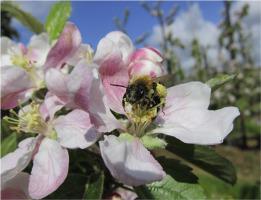当前位置:
X-MOL 学术
›
Agric. Ecosyst. Environ.
›
论文详情
Our official English website, www.x-mol.net, welcomes your feedback! (Note: you will need to create a separate account there.)
Quantifying crop pollinator-dependence and pollination deficits: The effects of experimental scale on yield and quality assessments
Agriculture, Ecosystems & Environment ( IF 6.6 ) Pub Date : 2020-12-01 , DOI: 10.1016/j.agee.2020.107106 Sean M. Webber , Michael P.D. Garratt , Martin Lukac , Alison P. Bailey , Theresa Huxley , Simon G. Potts
Agriculture, Ecosystems & Environment ( IF 6.6 ) Pub Date : 2020-12-01 , DOI: 10.1016/j.agee.2020.107106 Sean M. Webber , Michael P.D. Garratt , Martin Lukac , Alison P. Bailey , Theresa Huxley , Simon G. Potts

|
Abstract Many crops are known to be dependent on biotic pollination, but knowledge gaps remain regarding the extent of this dependence, how it varies between crop varieties, and the implications of biotic pollination for crop quality. Data is also lacking on the prevalence and extent of pollination deficits and the ability of the surrounding pollinator community to provide pollination services. Robust and standardised methodologies are crucial for pollination studies. However, there has been only limited research into the critical question of the appropriate scale to apply these methods. Here, we use a commercially important UK apple Malus domestica variety (Gala) to address the questions of pollinator-dependence and pollination deficits, quality benefits arising from pollination, and the implications of conducting pollination experiments at three different scales: the inflorescence, the branch, and the whole plant. We found that Gala apple production was highly dependent on biotic pollination: overall, pollinator exclusion reduced fruit set at harvest to 55 % of open pollination levels, whilst supplementary pollination led to fruit set of 167 %. However, significant differences were found between the inflorescence, branch, and tree experiments; with increasing scale of observation leading to a lower measure of pollinator-dependence and pollination deficit. At the inflorescence scale, fruit set at harvest was just 13 % of normal levels following pollinator exclusion, whilst at the branch and tree scales it was 75 % and 79 % of normal levels respectively. Supplementary pollination led to fruit set of 218 %, 172 %, and 117 % of normal rates at the inflorescence, branch, and tree scales respectively. Apple seed set was also significantly affected by pollination treatment and the extent of this effect also depended on experimental scale. These differences due to experimental scale are likely a combination of methodological, biological and crop management factors. Seed numbers were shown to be a very good indicator of a number of fruit quality parameters, with greater seed numbers resulting in greater production of Class 1 (i.e. top commercial value) fruit. It is recommended that to measure pollinator-dependence and pollination deficits, experiments are conducted at the largest scale practicable and that treatment effects are monitored until harvest to more accurately reflect final yield outcomes. For apples, growers are recommended to record seed number as part of their fruit quality monitoring programmes to give a rapid and easy to measure indication of potential pollination deficit.
中文翻译:

量化作物授粉依赖和授粉不足:实验规模对产量和质量评估的影响
摘要 众所周知,许多作物依赖于生物授粉,但在这种依赖程度、不同作物品种之间的差异以及生物授粉对作物质量的影响方面仍存在知识差距。还缺乏关于授粉缺陷的普遍性和程度以及周围授粉媒介社区提供授粉服务的能力的数据。稳健和标准化的方法对于授粉研究至关重要。然而,对于应用这些方法的适当规模的关键问题的研究非常有限。在这里,我们使用具有商业价值的英国苹果 Malusdomesica 品种 (Gala) 来解决授粉依赖和授粉不足、授粉带来的质量效益、以及在三个不同尺度上进行授粉实验的意义:花序、枝条和整株植物。我们发现 Gala 苹果的生产高度依赖于生物授粉:总体而言,排除授粉媒介将收获时的坐果率降低到开放授粉水平的 55%,而补充授粉导致坐果率为 167%。然而,在花序、分枝和树实验之间发现了显着差异;随着观察规模的扩大,传粉媒介依赖性和传粉不足的衡量标准降低。在花序尺度上,收获时的坐果率在排除传粉媒介后仅为正常水平的 13%,而在树枝和树木尺度上,分别为正常水平的 75% 和 79%。辅助授粉导致坐果率为 218%、172%、和分别在花序、树枝和树尺度上正常率的 117%。苹果种子结实也受授粉处理的显着影响,这种影响的程度也取决于实验规模。由于实验规模造成的这些差异可能是方法、生物和作物管理因素的组合。种子数被证明是许多水果质量参数的一个很好的指标,更多的种子数导致 1 类(即最高商业价值)水果的产量更高。建议测量授粉媒介依赖性和授粉缺陷,以可行的最大规模进行实验,并在收获前监测处理效果,以更准确地反映最终产量结果。对于苹果,
更新日期:2020-12-01
中文翻译:

量化作物授粉依赖和授粉不足:实验规模对产量和质量评估的影响
摘要 众所周知,许多作物依赖于生物授粉,但在这种依赖程度、不同作物品种之间的差异以及生物授粉对作物质量的影响方面仍存在知识差距。还缺乏关于授粉缺陷的普遍性和程度以及周围授粉媒介社区提供授粉服务的能力的数据。稳健和标准化的方法对于授粉研究至关重要。然而,对于应用这些方法的适当规模的关键问题的研究非常有限。在这里,我们使用具有商业价值的英国苹果 Malusdomesica 品种 (Gala) 来解决授粉依赖和授粉不足、授粉带来的质量效益、以及在三个不同尺度上进行授粉实验的意义:花序、枝条和整株植物。我们发现 Gala 苹果的生产高度依赖于生物授粉:总体而言,排除授粉媒介将收获时的坐果率降低到开放授粉水平的 55%,而补充授粉导致坐果率为 167%。然而,在花序、分枝和树实验之间发现了显着差异;随着观察规模的扩大,传粉媒介依赖性和传粉不足的衡量标准降低。在花序尺度上,收获时的坐果率在排除传粉媒介后仅为正常水平的 13%,而在树枝和树木尺度上,分别为正常水平的 75% 和 79%。辅助授粉导致坐果率为 218%、172%、和分别在花序、树枝和树尺度上正常率的 117%。苹果种子结实也受授粉处理的显着影响,这种影响的程度也取决于实验规模。由于实验规模造成的这些差异可能是方法、生物和作物管理因素的组合。种子数被证明是许多水果质量参数的一个很好的指标,更多的种子数导致 1 类(即最高商业价值)水果的产量更高。建议测量授粉媒介依赖性和授粉缺陷,以可行的最大规模进行实验,并在收获前监测处理效果,以更准确地反映最终产量结果。对于苹果,


























 京公网安备 11010802027423号
京公网安备 11010802027423号